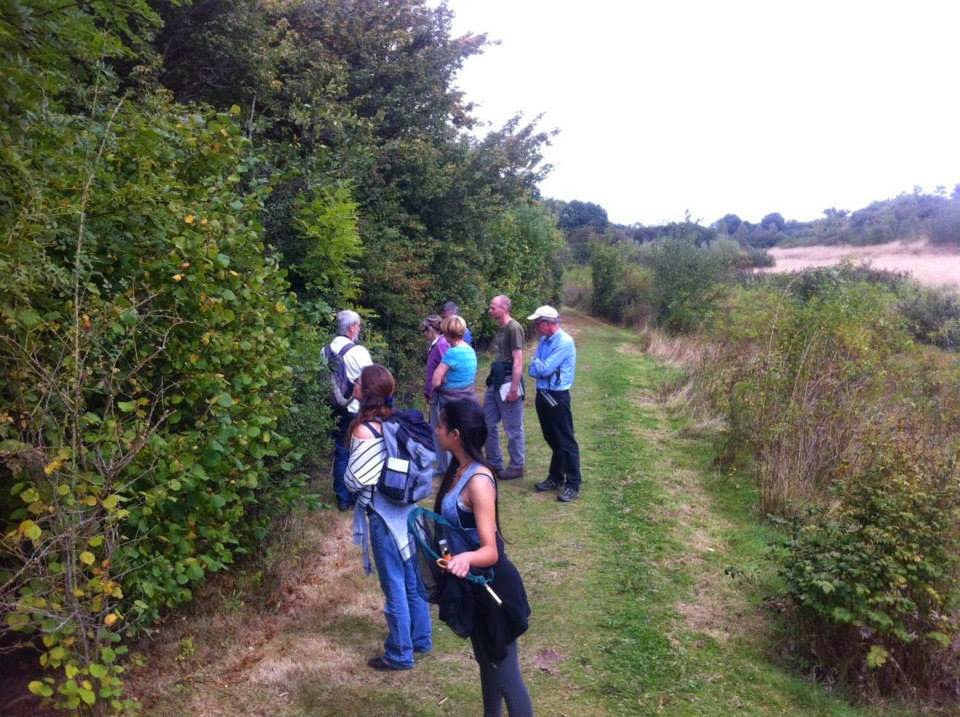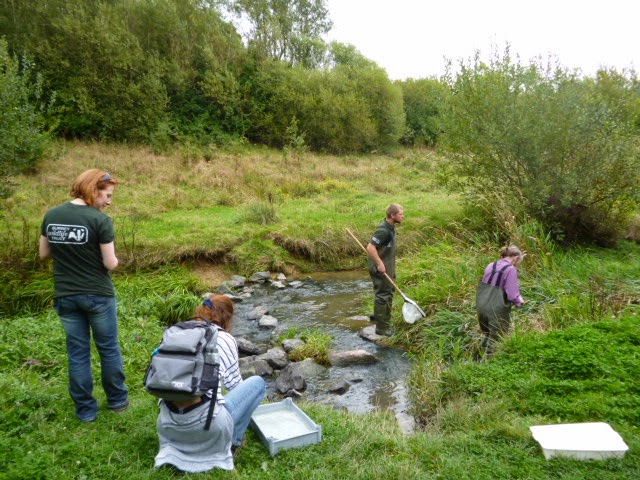Where: The River Mole, north of the airfield, Sussex/Surrey border (TQ260414)
When: 29.08.2014 (Friday night)
Who: Local residents, keen volunteers, professional conservationists, ecologists and representatives from Sussex Moth, Sussex Mammal and Surrey Bat Group.
Riverbank Basecamp with the moth light trap
Bat Trapping - Martyn Cooke
Time: 20:00
Harp Trap in woodlands (Photo by Maria Donoghue)
Martyn also kits out these traps with electronic lures, essentially a laptop and microphone which play out the social calls of different bat species, hopefully enticing them in.
Our bat detectors were picking up the rapid clicks of Common Pipistrelle bats and as we moved off, Martyn's detected the call of a species belonging to the 'Myotis' group. Could it be the rare and elusive Bechstein's Bat?
Time: 21:30
Small mammal surveying - Laurie Jackson
A crowd of people with headtorches comes in handy after the batteries in both of mine died!
(Photo by Tom Forward)
Over to the small mammal surveying areas where our Longworth traps were staked out. These humane traps are placed out in both woodland and grassland habitats, targeting as wide a suite of species as possible. Baited with porridge oats, apple, dried mealworms, peanut butter and some warm straw for bedding, how could any small mammal resist!
Scruffing small mammals for identification (Photo by Maria Donoghue)
As a result, we grabbed a good haul of small furry beasties this evening, including Bank Voles, Field Voles and Wood Mice, from which we collected biometric data. After weighing the wee rodent, Laurie then gently holds it by the scruff of the neck, checking its gender and general health.
Time: 22:30
Moth Trapping - Jake Everitt
A futuristic campfire - Photo by Maria Donoghue
Back to the moth trap (and the tea, coffee and biscuits) and we all gathered around the actinic light bulb. As well as attracting in passing Moths and Humans, this light proves tempting to plenty of other things such as Caddisflies, Shieldbugs and Lacewings.
Brightly coloured Brimstone Moths (Opisthograptis
luteolata) were one of the most numerous species this evening. Photo by Maria Donoghue
The odd Hornet tends to join us for a free feed, but its not our biscuits they are after...
European Hornet (Vespa crabro). Photo by Maria Donoghue
These chunky hymenopterans make short work of delicate moths, munching them up with their strong mandibles. If a whole lot of them get in the trap, you can end up identifying moths just by the remains of tattered wings. Jake bravely freed this one from its gluttonous prison by fishing it out with an insect pot.
Tins of biscuits prove an effective Human lure for Wildlife Recording Days
Jake and Tom F, a formidable team on any Bird Race,
dull company when comparing bird apps on their smartphones
It was then back to the bat traps for a final check... they remained determinedly empty. Not our luckiest night for bats, with only Common Pipistrelle and our mystery Myotis species turning up on the detectors. However, we totaled a good number of small mammals in the longworth traps, plus there would be plenty of moths to take a closer look at in the light of the day.
Saturday: 30.08.2014
Time: 09:00
Who: Around 30 people including keen naturalists, representatives from Surrey Biodiversity Records Centre, Wealden Dragonflies and Sussex Fungi Group
River Mole floodplain on the Saturday morning. Seriously, it's right by an airport!
Photo by Maria Donoghue
Sussex Wildlife Trust marquee and recording desk, manned by Kevin Lerwill of Gatwick Greenspace and Catherine Burton of Surrey Biodiversity Information Centre.
Back at basecamp, we had begun the day in earnest... with lots of chatting, drinking coffee and generally not getting very much done.
Time: 09:30
Small mammal surveying - Laurie Jackson
Emptying wee mammals into a bag for weighing
Someone took the initiative to get us all moving and our group split into two, half to carry out a bird survey and the others to check the mammal traps again. Our fingers were tightly crossed to find a Harvest Mouse (Mircomys minutus) as I had trapped one in this area only the day before...
Harvest Mice prefer to clamber up the stalks of grass and other vegetation, so we try to target them by putting some of the Longworth traps on stands
Common Shrew (Sorex araneus), re-orienting itself after being released. Photo by Maria Donoghue
Field Vole (Microtus agrestis). Photo by Maria Donoghue
No Harvest Mouse sightings today, but we did find ourselves evidence in the form of a nest right next to one of the traps, and that counts as a record!
Harvest Mouse nest in Tufted Hair Grass
Time: 09:30
Bird surveying - Tom Forward
In the meantime, Tom F was leading another group along the riverbank to collect some bird records. They got some great bird of prey action, including Common Buzzards, Sparrowhawks and this awesome little Kestrel.
Common Kestrel (Falco tinnunculus) Photo by Maria Donoghue
Reed Warbler and Reed Bunting could be heard by keen ears along the river
Great views (and songs) of a European Robin (Erithacus rubecula). Photo by Maria Donoghue
Time: 10:30
Moth Trap reveal - Jake Everitt
The moth traps had been sealed overnight and now was the time to go through the contents, listing all of the species...
Moths drawing a crowd. Photo by Tom Forward
Jake Everitt of Sussex Moth Group.
The moths were quite obliging in the light of the day, sitting quite still for their close ups...
Centre-barred Sallow (Atethmia centrago). Photo by Martyn Cooke
Angle
Shades (Phlogophora meticulosa). Photo by Martyn Cooke
Mother
of Pearl (Pleuroptya ruralis). Photo by Martyn Cooke
Ello mates! A crowd of Large Yellow Underwing (Noctua
pronuba). Photo by Martyn Cooke)
Time: 11:30
Terrestrial invertebrates
It was onto recording invertebrates and the sun was putting on a good show, warming up those things with wings. Seeing as everyone had become quite familiar with the site, naturalists with cameras, nets, paper and pens were let loose in all directions.
We were incredibly fortunate to have on our site a selection of keen invertebrate recorders, all specialising in their different groups. These photos are just a tiny subset of their final species lists:
We were incredibly fortunate to have on our site a selection of keen invertebrate recorders, all specialising in their different groups. These photos are just a tiny subset of their final species lists:
Hoverflies and Bees - Jeremy Early
Tree Bumblebee (Bombus hypnorum) queen. Photo by Jeremy Early
Bumblebee Mimic Hoverfly (Eristalis intricarius) Photo by Jeremy Early
Hornet Mimic Hoverfly (Volucella zonaria) Photo by David Chelmick
Butterflies - Harry Clarke
Common Blue (Polyommatus
icarus) female. Photo by Jeremy Early
Checking the hedgerows
Comma Butterfly (Polygonia
c-album) on Blackberries. Photo by Maria Donoghue
Excitingly, a rare Brown Hairstreak Butterfly (Thecla betulae) also put in an appearance, however the crowd was slightly off the ball with all their cameras!
Dragonflies - David Chelmick
Mr Chelmick has been on a personal mission to prove the presence of Willow Emerald Damselfly (Lestes viridis) along Gatwick's section of the River Mole. He emphatically believes this recent arrival to Britain has to be here someplace...
Common Darter (Sympetrum
striolatum). Photo by Maria Donoghue
Common Darter (Sympetrum striolatum) on naturalist. Photo by Maria Donoghue
Migrant Hawker (Aeshna
mixta). Photo by Tom Forward
Sadly, no Willow Emeralds were to be found on this day, however there was a very unexpected surprise in the form of a Golden-ringed Dragonfly, far away from its usual heathland habitat!
Bugs, hoppers and other terrestrial groups -Andrew Halstead and Roger Hawkins
These chaps did a brilliant job of boosting our invertebrate species list with less well known groups...
Forest Shield Bug (Pentatoma
rufipes)
Harvestman (Mitopus
morio). Photo by Jeremy Early
Tom F and Tom S, helping with the identification of Crickets and Grasshoppers
Time: 13:30
Time for a lunch break. People relaxed by the river while Catherine did a quick species tally...
These guys were super keen though and couldn't sit down for long....
Is it a bird, is it a plane?
Probably.
Time: 14:00
Plants - Arthur Hoare
Botanical records make up a huge part of any species list on a recording day, and our floodplain is a mecca for botanising!
Creeping Thistle (Cirsium arvense). Photo by Maria Donoghue
Broadleaf Arrowhead (Sagittaria latifolia). Photo by Maria Donoghue
Wild Carrot (Daucus carota). Photo by Maria Donoghue
Fungi - Nick Aplin
Nick knows this area well and is a most welcome addition to a diverse team of naturalists...
Scotch Bonnet Fungus (Marasmius
oreades). Photo by Nick Aplin
Phialina (Calycellina) ulmariae growing on Meadowsweet stems
This species is possibly a new record for vice-county Surrey. Photo by Nick Aplin
This species is possibly a new record for vice-county Surrey. Photo by Nick Aplin
Plus Nick's personal favourite: Calyptella capula on Rabbit poo.
Photo by Nick Aplin
Aquatic invertebrates - Tom Simpson and David Chelmick
Wading in the River Mole: We selected areas with differing silt levels and flow rates to see what we could find.
Invertebrate kick-sampling is quite self-explanatory; Tom stood in the silt, held the net downstream and kicked up aquatic minibeasts from the silty river bottom.
David draws in the crowd with his battle cry of 'Odonata!' (That's dragonflies to you and me)
White-legged Damselfly larva (Platycnemis
pennipes). Photo by Maria Donoghue
American Signal Crayfish (Pacifastacus
leniusculus), an invasive species which we trap to remove along the River Mole. Photo by Martyn Cooke
Also a few more vertebrate species to add to the list...
Stone Loach (Barbatula barbatula)
....and since I had forgotten to put out any refugia, not a single reptile record today!
Knackered naturalists
At the end of the day, we had totaled 215 species. As of now, we are officially up to 298, with probably more to come!
A rough breakdown of the species groups:
Massive thank yous are in order to Kevin, Catherine, Tom F, Tom S, Laurie, Martyn, Jake, David, Jeremy, Nick and absolutely everyone else who came along on the day and helped make it so memorable. You may rest now.
Here are a few of the natural history groups who were respresented on the day:
We hope to see you all again next year!



























































No comments :
Post a Comment